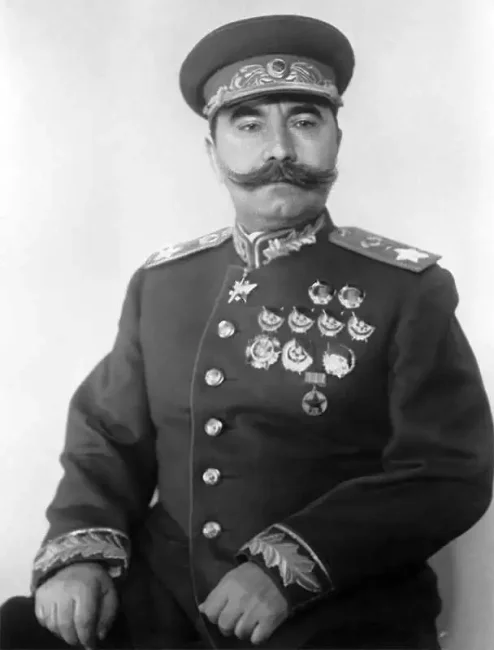- Military History
- Biographies
- Militarians Biographies
- Marshal of the Soviet Union Semyon Mikhailovich Budyonny
Marshal of the Soviet Union Semyon Mikhailovich Budyonny
A Russian military commander of the old school, passionately devoted to the cavalry
Semyon Mikhailovich Budyonny (Russian: Семён Миха́йлович Будённый) was born near Rostov-on-the-Don, the heart of the Don Cossack region, where he was steeped in the fighting traditions of the Cossack's. Although he received no formal education, Budyonny was literate.
He entered military service as an enlisted cavalryman in 1903 and took part in the Russo-Japanese War, although he saw no significant action. Despite this, Budyonny's superiors appreciated the young man's potential, and he was enrolled in the St. Petersburg Riding School of Imperial Cavalry in 1909. On graduation, they promoted him to sergeant-major, the highest noncommissioned rank in the czar's army.
Budyonny served valiantly and extensively in World War I and received four St. George's Crosses for gallantry. With the outbreak of the Russian Revolution, Budyonny, who was not a political revolutionary, sided with the Bolsheviks. He was appointed to his division's soldier's soviet and formed a cavalry unit that successfully cleared Platovskaia of White (Czarist) forces during February 1918.
Budyonny grew his unit to brigade proportions and under heavy White onslaught retreated to the north, where he joined forces with troops under Josef Stalin and Kliment Yefremovich Voroshilov. Budyonny was assigned command of the cavalry division in Voroshilov's Tenth Army and helped to retake Tsaritsyn during January 1919.
As commander of the Cavalry Corps in June, Budyonny deliberately disobeyed orders to avoid engaging the superior White cavalry forces around Orenburg and Voronezh. His bold gamble paid off and Budyonny emerged victorious in October. Following this triumph, the Cavalry Corps was upgraded to the First Cavalry Army (known as the Konarmiya) and leading it Budyonny defeated White forces in a critical battle at Bataysk near Rostov in January 1920.
The Russian Civil War merged with the Russo-Polish War, and Budyonny's army was dispatched to repulse Poles advancing into the Ukraine. On May 30, 1920, Budyonny crossed the Dnieper River with 16,500 cavalry troopers and pushed through Polish lines at the Uman River by early June.
In a remarkable 200-kilometer advance, Budyonny engaged and smashed the Sixth Polish Army at Berdichev. Budyonny unfortunately failed to coordinate his further advance on the city of L'vov with the action of other units and soon found himself encircled. Keeping his sense of command, he fought free by September and was dispatched to the south, where he and the First Cavalry Army played a key role in the conquest of the Crimea (October 1920 - January 1921).
Budyonny's distinguished record prompted his elevation to assistant for cavalry to the commander-in-chief and gained him membership in the Revolutionary Military Council by 1923. Budyonny's close association with Stalin (already political commissar by the time of the Polish War), helped secure great power and influence for Budyonny, who set about reshaping the Red Army during the 1920s and 1930s.
He was chiefly responsible for the army's anachronistic reliance on cavalry; there were thirty cavalry divisions by 1938. The emphasis on cavalry retarded the mechanization of the Red Army, which put it at a severe disadvantage compared to the highly mechanized German army.
Budyonny was appointed one of the first five Marshal of the Soviet Union in 1935 and weathering Stalin's brutal purges of the military, he rose to the position of deputy commissar of defense on the eve of World War II (1939).
When Adolf Hitler violated his pact with Stalin and invaded the Soviet Union in June 1941, Budyonny was named commander of the Soviet Reserve Army and stationed on the Southwest front with orders to defend Kiev. In July, facing overwhelming Nazi numbers, he urged retreat. Stalin refused Budyonny's request and soon the invaders surrounded his 600,000 men. Budyonny escaped capture only because he was evacuated by air in September.
Following the Kiev debacle, Budyonny was named to command along the North Caucasus Front from May to September 1942 and then was given full command of the Red Army cavalry, beginning in May 1943. By this time, the grandiose post was political.
Budyonny was given no additional field or operational commands but served as a member of the Party Central Committee from 1939 to 1952 and as a "candidate member" of the committee from 1952 until his death in 1973.
This final honorary post reflected his enduring popularity as a Hero of the Soviet Union despite his remarkable lack of success during World War II, which not only included failure in battle but the even graver failure to prepare the Red Army adequately for twentieth-century warfare.
Marshal of the Soviet Union Semyon Mikhailovich Budyonny - Quick Facts
- Russian Empire (1700 - 1917)
- Russia Soviet Union (1918-92)
- 1st Cavalry Army (Red Army)
- Chinese Red Army (Workers' and Peasants' Red Army 1928-1937)
- Imperial Russian Army (Russian Empire)
- Russo-Japanese War (1904-1905)
- WWI (1914-1918)
- Russian Civil War (1917-1922)
- Polish - Soviet War (1919-1921)
- WWII (1939-1945)
- Cold War (1947-1991)
- {{#owner}}
- {{#url}} {{#avatarSrc}}
{{name}} {{/url}} {{^url}} {{#avatar}} {{& avatar}} {{/avatar}} {{name}} {{/url}} - {{/owner}} {{#created}}
- {{created}} {{/created}}
























